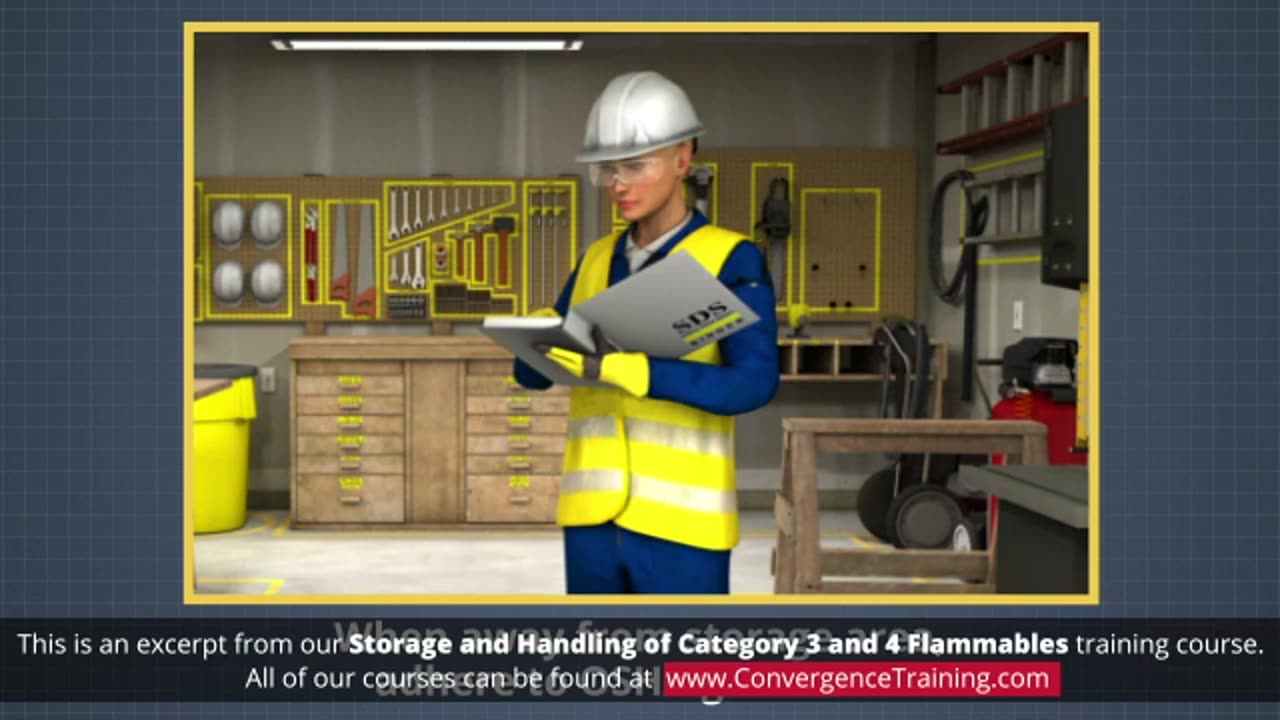Premium Only Content

Storage and Handling of Category 3 and 4 Flammables Training
**Training on Storage and Handling of Category 3 and 4 Flammables** is vital for maintaining workplace safety, especially in industries dealing with fuels, solvents, or chemicals. Proper training ensures compliance with fire codes, reduces fire risks, and protects personnel and property. Below is a structured outline for the training course:
---
### **Training Objectives**
- Understand the characteristics of Category 3 and 4 flammable liquids.
- Learn proper storage practices to minimize risks.
- Master safe handling procedures to prevent accidents.
- Familiarize with fire prevention measures and emergency response protocols.
---
### **Course Content**
#### **1. Introduction to Flammables**
- **Definition and Classification:**
- **Category 3 Flammables:** Flash point >23°C (73°F) but ≤60°C (140°F).
- **Category 4 Flammables:** Flash point >60°C (140°F) but ≤93°C (200°F).
- Examples of Category 3 and 4 flammables:
- Category 3: Paint thinners, gasoline blends, some alcohols.
- Category 4: Diesel fuel, certain heating oils.
- **Hazards of Flammable Liquids:**
- Fire and explosion risks.
- Toxicity and health effects from vapor exposure.
---
#### **2. Storage Requirements**
- **Regulatory Standards:**
- OSHA 1910.106 (Flammable and Combustible Liquids).
- NFPA 30 (Flammable and Combustible Liquids Code).
- **Approved Storage Containers:**
- Safety cans and drums with proper labeling.
- Secondary containment systems to prevent leaks or spills.
- **Storage Locations:**
- Well-ventilated areas away from heat sources.
- Distance from ignition points (open flames, sparks, hot surfaces).
- Separation from incompatible materials (e.g., oxidizers).
- **Fire Protection:**
- Use of fire-resistant cabinets for storage.
- Maintaining appropriate fire extinguishers (e.g., Class B extinguishers).
---
#### **3. Handling Precautions**
- **Safe Handling Practices:**
- Use grounded and bonded equipment to prevent static discharge.
- Transfer flammables in designated areas with spill containment.
- Avoid overfilling containers to allow for liquid expansion.
- **Personal Protective Equipment (PPE):**
- Flame-resistant clothing, chemical-resistant gloves, and goggles.
- Respirators if working in areas with inadequate ventilation.
- **Control of Vapors:**
- Keep containers tightly closed.
- Ensure proper ventilation in storage and handling areas.
---
#### **4. Spill and Leak Response**
- **Immediate Actions:**
- Evacuate the area and eliminate ignition sources.
- Contain the spill using absorbents or dikes.
- Notify supervisors and emergency response teams.
- **Cleanup Procedures:**
- Use non-sparking tools for cleanup.
- Dispose of waste as per hazardous waste regulations.
- **Documentation and Reporting:**
- Record the incident and actions taken to prevent recurrence.
---
#### **5. Fire Prevention Measures**
- **Eliminating Ignition Sources:**
- Prohibit smoking and open flames near storage areas.
- Use explosion-proof electrical fixtures.
- **Workplace Safety Systems:**
- Installation of ventilation systems and vapor detectors.
- Conducting regular safety audits and inspections.
- **Employee Training:**
- Ongoing education on flammable liquid safety.
- Emergency evacuation drills.
---
#### **6. Emergency Response Procedures**
- **Firefighting Protocols:**
- Use correct fire extinguishers for flammable liquid fires.
- Do not use water on flammable liquid fires unless specifically advised.
- **Evacuation Plans:**
- Clearly marked exits and assembly points.
- Assigning responsibilities to safety personnel (e.g., fire wardens).
- **First Aid Measures:**
- Treating burns or vapor exposure.
- Immediate medical attention for severe incidents.
---
### **Practical Training Component**
- Hands-on demonstration of:
- Proper transfer techniques using grounded equipment.
- Safe storage in flammable cabinets.
- Responding to simulated spills or fires.
- Familiarization with safety data sheets (SDS) for flammable liquids.
---
### **Course Tools and Resources**
- **Visual Aids:** Charts showing flash points, storage setups, and spill responses.
- **Interactive Sessions:** Role-playing exercises for spill and fire emergencies.
- **Compliance Materials:** Quick reference guides for OSHA and NFPA standards.
---
### **Certification**
Participants should pass a written test and a practical demonstration to receive a certificate of competency in handling Category 3 and 4 flammables.
Would you like assistance in developing detailed training materials, such as slide decks, safety checklists, or emergency drill scripts?
-
 7:58
7:58
HSESafetyInformation
8 months agoAuthentic Peshawari Rosh _ Namkeen Gosht Recipe __ Traditional KPK and Baluchistan
741 -
 6:14
6:14
PistonPop-TV
1 day agoThe VW 07K: The Indestructible Five-Cylinder with Lamborghini DNA
4.16K -
 11:40
11:40
ThinkStory
17 hours agoFRANKENSTEIN Ending Explained!
1.52K2 -
 33:05
33:05
ArturRehi
1 day ago1,000 Shahed Drones Explode at the same time in a BEHEMOTH FIREBALL in Donetsk
3.52K -
 15:36
15:36
JohnXSantos
1 day agoHow To Design A Luxury Clothing Brand With A.I (From 0-$100+)
20 -
 1:55:13
1:55:13
The Kevin Trudeau Show Limitless
3 days agoHow To Pray To Get Results!
4.38K5 -
 1:17:46
1:17:46
Squaring The Circle, A Randall Carlson Podcast
22 hours agoRandall Carlson Defines The Younger Dryas
3.33K4 -
 40:03
40:03
WanderingWithWine
7 days ago $0.07 earnedBuy a Home for Less Than a Car? 5 Italian Homes for Sale in Puglia
2.76K2 -
 10:09
10:09
Advanced Level Diagnostics
2 days agoWhy I Never Use Cheap Fuses!
1.71K -
 10:23
10:23
Forrest Galante
3 hours agoAsking an Indian Billionaire Why He Is Saving 1 Million Animals
59.1K13